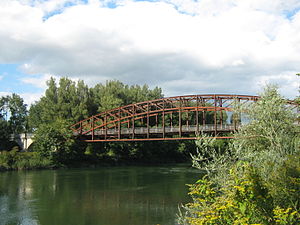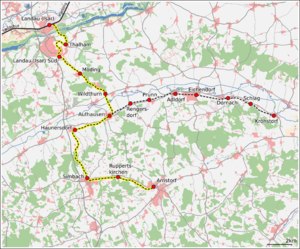Landau – Arnstorf railway line
| Landau – Arnstorf | |||||||||||||||||||||||||||||||||||||||||||||||||||||||||||||||||
|---|---|---|---|---|---|---|---|---|---|---|---|---|---|---|---|---|---|---|---|---|---|---|---|---|---|---|---|---|---|---|---|---|---|---|---|---|---|---|---|---|---|---|---|---|---|---|---|---|---|---|---|---|---|---|---|---|---|---|---|---|---|---|---|---|---|
|
Bockerl Bridge over the Isar
| |||||||||||||||||||||||||||||||||||||||||||||||||||||||||||||||||
| Route number : | 5640 | ||||||||||||||||||||||||||||||||||||||||||||||||||||||||||||||||
| Course book section (DB) : | lastly 426a | ||||||||||||||||||||||||||||||||||||||||||||||||||||||||||||||||
| Route length: | 24.22 km | ||||||||||||||||||||||||||||||||||||||||||||||||||||||||||||||||
| Gauge : | 1435 mm ( standard gauge ) | ||||||||||||||||||||||||||||||||||||||||||||||||||||||||||||||||
|
|||||||||||||||||||||||||||||||||||||||||||||||||||||||||||||||||
The Landau – Arnstorf railway was a branch line from Landau an der Isar to Arnstorf in Lower Bavaria . It was called the Bockerlbahn in the region .
preparation
At the end of the 19th century, the area around the Arnstorf and Eichendorf markets was surrounded by railway lines, but none of them led into the area. On April 1, 1894, there was a public meeting in Arnstorf with representatives from 24 participating communities, which came to the conclusion to apply for a railway to Arnstorf, although the starting point was left open.
The general management of the royal transport authorities pushed for a decision between Landau or Eggenfelden as the starting point for the route to Arnstorf. On January 18, 1896, the mayors Zöllner von Arnstorf and Steinbauer von Landau submitted a proposal for a railway line from Landau to Arnstorf. After further discussions, for example about the possibility of extending the route to Münchsdorf, the local railway Landau (Isar) -Arnstorf was approved by law of June 30, 1900.
construction
The construction costs were estimated at 2,114,000 marks, those interested had to raise 157,500 marks. At that time Arnstorf had 1,400 inhabitants, Simbach over 700 and Eichendorf over 1,100. A total of 18,400 inhabitants lived in the traffic area along the route.
On July 4, 1900, Landauer and Arnstorfer met for a joint celebration and sent a greeting and thank you telegram to the state government. The district doctor and member of the state parliament, Dr. Josef Hauber.
300,000 cubic meters of earth had to be moved during construction. As usual, the interested parties had to make the land available for the railway construction free of charge. Since Arnstorf had to raise his share of 50,000 marks through a loan, the municipal council decided on May 10, 1901 to repay a local malt surcharge of 1.40 marks per hectolitre of soaked malt, which meant an increase in the price of beer from 20 pfennigs to 22 pfennigs per liter. Despite some unrest, this measure was implemented.
Bockerl Bridge
The Bockerl Bridge over the Isar in Landau, completed in 1903 and later known as the Bockerl Bridge, was the longest self-supporting steel bridge in Bavaria at the time . It was built especially for the railway line and is now a listed building .
The Bockerl Bridge consists of a box bridge made of mild steel on a concrete substructure, two five- or two-arched stamped concrete bridges and an iron stud arch bridge, connected by a route on the embankment.
business
The line was opened on December 29, 1903 and rail operations started on New Year's Eve. She left Landau station on the east side and turned in a sharp arc towards the valley of the Isar , which she crossed. It reached the watershed between Isar and Vils at an altitude of 420 meters and crossed the Vils near Aufhausen on a flood-free dam. South of Haunersdorf, it climbed to its second peak at the height between Vils- and Kollbachtal at 445 meters. Simultaneously with the Distriktstrasse, it reached the Arnstorf train station, a massive three-story building on the northwest side of the market.
In 1908 it was decided to build the Aufhausen – Kröhstorf railway line , but this branch line could not be opened until 1915, so that the Eichendorf market was also connected to the railway. On December 30, 1953, a large anniversary celebration was held to mark its 50th anniversary. The anniversary special train with the festively decorated locomotive 64 438 left Landau at 1:10 p.m. and arrived in Arnstorf at 2:31 p.m.
However, the company became increasingly unprofitable. The number of tickets sold in Arnstorf fell from 13,624 in 1952 to 9,417 in 1958 to 836 in 1963, the amount of wagonloads sent from 6,235 tons (1952) to 4,046 tons to 1,415 tons (1963) 9,413 tons (1952) to 6,898 tons, but then increased again to 8,688 tons (1963). At Simbach train station there was also a drastic decrease in the number of tickets sold in the same years from 11,086 to 8,063 to 681, the mass of wagon loads sent rose from 643 tons to 1,625 tons and then fell to 544 tons. On the other hand, the wagonloads at the reception increased from 2,573 tons in 1952 to 3,877 tons in 1958 to 5,014 tons in 1963.
Shutdown
From the summer timetable of 1961 onwards, rail buses were used in each direction when the number of trains was reduced . Uerdinger rail buses had already succeeded the trains with the 64 series . On September 27, 1964, the passenger train service was stopped, small locomotives took over the goods traffic, only in the autumn when the sugar beet was harvested there was still a lively operation.
After the freight hall in Arnstorf and the Haunersdorf train station were demolished, the Wildthurn train station was demolished in January 1978. On July 10, 1982, a passenger train ran again when the company Akustikbau Lindner rented a large special train for their company outing. Freight traffic was finally stopped on November 30, 1993, the shutdown followed on May 28, 1994, the tracks were dismantled in 1998. On August 24, 1999, the former Bockerlbahn -radweg Landau a. d. Isar – Arnstorf opened.
Web links
literature
- Walther Zeitler: Railways in Lower Bavaria and Upper Palatinate . Buch & Kunstverlag Oberpfalz, Weiden 1985, ISBN 3-924350-01-9 .

